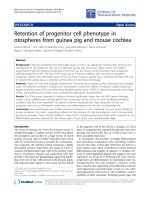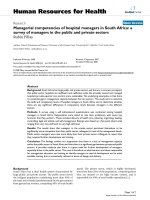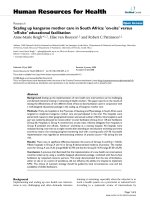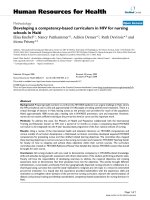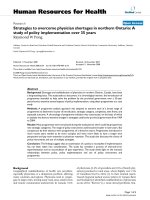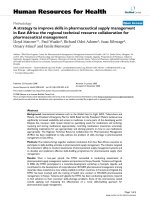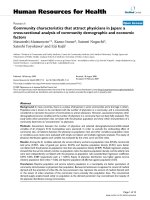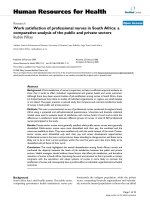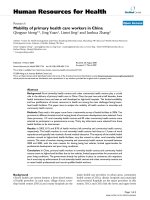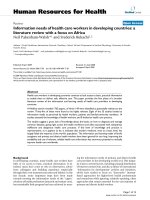báo cáo sinh học:" Scaling up kangaroo mother care in South Africa: ''''on-site'''' versus ''''off-site'''' educational facilitation" ppt
Bạn đang xem bản rút gọn của tài liệu. Xem và tải ngay bản đầy đủ của tài liệu tại đây (260.17 KB, 6 trang )
BioMed Central
Page 1 of 6
(page number not for citation purposes)
Human Resources for Health
Open Access
Research
Scaling up kangaroo mother care in South Africa: 'on-site' versus
'off-site' educational facilitation
Anne-Marie Bergh*
1,2
, Elise van Rooyen
1,3
and Robert C Pattinson
1,2
Address:
1
MRC Research Unit for Maternal and Infant Health Care Strategies, South Africa,
2
Department of Obstetrics and Gynaecology, University
of Pretoria, South Africa and
3
Department of Paediatrics, University of Pretoria, South Africa
Email: Anne-Marie Bergh* - ; Elise van Rooyen - ;
Robert C Pattinson -
* Corresponding author
Abstract
Background: Scaling up the implementation of new health care interventions can be challenging
and demand intensive training or retraining of health workers. This paper reports on the results of
testing the effectiveness of two different kinds of face-to-face facilitation used in conjunction with
a well-designed educational package in the scaling up of kangaroo mother care.
Methods: Thirty-six hospitals in the Provinces of Gauteng and Mpumalanga in South Africa were
targeted to implement kangaroo mother care and participated in the trial. The hospitals were
paired with respect to their geographical location and annual number of births. One hospital in each
pair was randomly allocated to receive either 'on-site' facilitation (Group A) or 'off-site' facilitation
(Group B). Hospitals in Group A received two on-site visits, whereas delegates from hospitals in
Group B attended one off-site, 'hands-on' workshop at a training hospital. All hospitals were
evaluated during a site visit six to eight months after attending an introductory workshop and were
scored by means of an existing progress-monitoring tool with a scoring scale of 0–30. Successful
implementation was regarded as demonstrating evidence of practice (score >10) during the site
visit.
Results: There was no significant difference between the scores of Groups A and B (p = 0.633).
Fifteen hospitals in Group A and 16 in Group B demonstrated evidence of practice. The median
score for Group A was 16.52 (range 00.00–23.79) and that for Group B 14.76 (range 07.50–23.29).
Conclusion: A previous trial illustrated that the implementation of a new health care intervention
could be scaled up by using a carefully designed educational package, combined with face-to-face
facilitation by respected resource persons. This study demonstrated that the site of facilitation,
either on site or at a centre of excellence, did not influence the ability of a hospital to implement
KMC. The choice of outreach strategy should be guided by local circumstances, cost and the
availability of skilled facilitators.
Background
Implementing and scaling up new health care interven-
tions is very challenging and often demands intensive
training or retraining, especially when the objective is to
reach a health system on a provincial or national level.
According to a systematic review of interventions by
Published: 23 July 2008
Human Resources for Health 2008, 6:13 doi:10.1186/1478-4491-6-13
Received: 4 January 2008
Accepted: 23 July 2008
This article is available from: />© 2008 Bergh et al; licensee BioMed Central Ltd.
This is an Open Access article distributed under the terms of the Creative Commons Attribution License ( />),
which permits unrestricted use, distribution, and reproduction in any medium, provided the original work is properly cited.
Human Resources for Health 2008, 6:13 />Page 2 of 6
(page number not for citation purposes)
Grimshaw et al., the successful implementation of a pro-
gramme depends, among others, on face-to-face commu-
nication, the use of a multimedia package for training, the
development of protocols and guidelines within individ-
ual institutions, and opinion leaders at grassroots level
who are convinced of the value of the programme [1]. As
this is an expensive option in terms of human resources
requirements for the introduction of new health care
interventions, the South African Medical Research Coun-
cil's (MRC) Research Unit for Maternal and Infant Health
Care Strategies is involved in a long-term research pro-
gramme to test the effectiveness of different outreach strat-
egies for scaling up interventions or quality improvement
programmes, some of which could potentially be more
cost-efficient. This is being done in collaboration with dif-
ferent provincial and local health care authorities, and
involves primary health care clinics, community health
centres and hospitals. Four initiatives are currently under
way – kangaroo mother care (KMC), basic antenatal care,
basic intrapartum care and essential steps in postpartum
care.
The focus of the kangaroo mother care initiative was to
introduce KMC in all health care facilities in South Africa,
starting with hospitals that provide newborn care, fol-
lowed by home-based KMC in the community. KMC, the
method of choice for hospitals caring for stable immature
infants [2], is an alternative to conventional incubator
and bassinet care. The infant is positioned skin-to-skin
between the mother's breasts and secured firmly. KMC
programmes also include the promotion of breastfeeding
and the ambulatory support of mothers after discharge.
The advantages and practice of KMC, even for unstable
low birth-weight infants and healthy newborns, have
been well documented and described in the literature [3-
8].
The effectiveness of three different outreach strategies in
provincial scale-up programmes has now been tested in
South Africa, using KMC as the example of a new health
care intervention. Although hospitals were used in this
study, the principles are also applicable and the findings
transferable to community-based interventions. In 2002,
two strategies were tested as part of the Ukugona Outreach
in the Province of KwaZulu-Natal. Hospitals were paired
and assigned either to receiving an evidence-based multi-
media educational package on its own or to receiving on-
site regional facilitation in conjunction with the use of the
package. The results of the study confirmed Grimshaw et
al.'s observation [1] – facilitation using an on-site, face-to-
face strategy, combined with a carefully designed imple-
mentation package, was found to be significantly more
effective than using the package on its own [9].
When the MRC Unit was approached by the Ministries of
Health of the Gauteng and Mpumalanga Provinces to
assist with the implementation of KMC, the opportunity
arose, for the first time, to test the effectiveness of two dif-
ferent outreach strategies using face-to-face facilitation.
The two strategies were 'on-site', face-to-face facilitation at
individual health care facilities (a strategy that had been
demonstrated to be effective in the first trial) and 'off-site',
face-to-face facilitation at a centre of excellence (the 'new'
intervention). The design and results of this trial will be
described in this paper.
Implementation process
Ideally a new health care intervention should be intro-
duced in all the relevant health care facilities simultane-
ously. This was the approach followed in the Ukugona
Outreach [9]. However, practical constraints, budgetary
considerations and the availability of human resources
are realities that often have to be taken into account when
planning an outreach. Both provinces participating in this
study decided on a staggered approach, whereby a certain
number of the targeted hospitals were included in the out-
reach each year. The Sub-directorate: Maternal, Child and
Women's Health of the Gauteng Department of Health
was responsible for the implementation of KMC in this
province. They launched the Fara Ngwana ('hold the
baby') outreach in August 2003. In the Mpumalanga Prov-
ince the Ukubamba Umtwana Kuwe ('hold the baby
tightly') outreach, launched in March 2004, was the
responsibility of the Subdirectorate: Nutrition of the
Department of Health and Social Services and was one of
the priority programmes of the Integrated Nutrition Pro-
gramme. In Gauteng seven hospitals were targeted for
implementation support in 2003 and another five in
2005. In Mpumalanga seven hospitals were targeted for
2004, 11 for 2005 and eight for 2006. All the hospitals in
the trial were state-run, public hospitals.
Methods
The research proposal was approved by the Research Eth-
ics Committee of the Faculty of Health Sciences, Univer-
sity of Pretoria (No 16/2002).
Thirty-six hospitals were eligible to participate in the ran-
domised trial to test the effectiveness of two face-to-face
facilitation strategies. The hospitals were paired with
respect to their level of care, their geographical location
(urban or rural) and the annual number of births at each
facility (which varied between 200 and 7600 births per
year). One hospital in each pair was randomly allocated
to Group A, the other to Group B, by spinning a coin.
Group A received on-site facilitation and Group B off-site
facilitation.
Human Resources for Health 2008, 6:13 />Page 3 of 6
(page number not for citation purposes)
Facilitation process
The facilitation process followed a very distinct pattern in
all cases. Hospitals were invited to voluntarily participate
in the outreach. The Chief Executive Officer (CEO) of each
hospital was required to sign a commitment of participa-
tion. All hospitals sent a multi-professional task team of
three to six delegates to an introductory workshop. The
task teams consisted of different combinations of manag-
ers, doctors, midwives, nurses, dieticians, occupational
therapists, speech therapists, physiotherapists and social
workers. The choice of which delegates should attend the
workshop was left to the managers of the participating
hospitals. At this workshop the delegates received training
in the theory and practice of KMC and participated in
practical activities related to the implementation process.
Each hospital received an implementation package and
was informed about the outreach strategy to which it had
been allocated. The duration of the introductory work-
shop in Mpumalanga was two days and in Gauteng only
one day, as health workers were more familiar with KMC
as a result of previous training workshops.
'On-site' facilitation (Group A) entailed two site visits to
hospitals, lasting two to three hours each. This started six
to eight weeks after the introductory workshop and took
place at four-weekly intervals. 'Off-site' facilitation
(Group B) entailed a one- or two-day, 'hands-on' training
workshop at hospitals identified as centres of excellence.
This took place six to eight weeks after the introductory
workshop. Three training centres, one in Gauteng and two
in Mpumalanga, had well established KMC units and
were available for this study. All three were regional hos-
pitals with neonatal intensive care facilities. Figure 1 pro-
vides a graphic depiction of the process followed.
The same two resource persons conducted the introduc-
tory workshop and attended almost all of the facilitation
sessions, one concentrating on clinical issues (EvR), the
other on implementation issues (A-MB). The content of
the workshop and facilitation sessions was built around
an evidence-based workbook [10], which is part of the
implementation package. An important aspect of the
introductory workshop was the development of a plan of
action by each hospital. This was photocopied and with
each on-site or off-site visit participants were requested to
give a presentation on their progress. At the end of each
facilitation session, hospitals had to commit themselves
to further steps in implementation, against which their
progress could be measured at the next visit or at the
assessment visit at the end.
Outcome measures
Six to eight months after the introductory workshop each
hospital was visited and scored by means of a standard-
ised instrument [11]. The evaluation team consisted of the
two facilitators (A-MB & EvR), the provincial coordinators
and other assessors trained in each province. The assess-
ment instrument is based on a progress-monitoring
model (see figure 2) that is divided into three phases: pre-
implementation, implementation and institutionalisa-
tion. Each of these phases consists of two steps, starting
with raising awareness and encouraging the hospital to
take a conscious decision to implement, through to the
hospital's taking ownership and showing evidence of
practice, up to evidence of routine and institutionalised
practice, with the ultimate goal being sustainable practice.
Each step has specific indicators that are scored according
to a weighted system [11]. The maximum score is 30 and
hospitals scoring more than 10 out of 30 have reached the
level of 'evidence of practice'. (See figure 3.)
Results
Using the Wilcoxon paired ranked test, no significant dif-
ference was found in the effectiveness of the two outreach
strategies (p = 0.633). The median score for the on-site
The progress-monitoring modelFigure 2
The progress-monitoring model. Adapted from Bergh et
al. (2005) [11].
1. Creating awareness
2. Adopting the concept
3. Taking ownership
4. Evidence of
practice
5. Evidence of
routine and
integration
6. Sustainable
practice
,
1
6
7
,
7
8
7
,
2
1
$
/
,
6
$
7
,
2
1
0 RELOLVDWLRQRIUHVRXUFHV
KXP DQVSDFHHTXLSP HQW
&RQVFLRXVGHFLVLRQWRLP SOHP HQW
% D E LH V LQ . 0 & S R V LW LR Q
3DWLHQWUHFRUGV
6WDIIRULHQWDWLRQ
$ ZDUHQHVVE\P DQDJHP HQW
\HDUDXGLW
HYLGHQFH
6WDIIGHYHORSP HQW
( Y LG H Q F H R I D OOW K U H H
FRP SRQHQWVRI.0 &
3ROLFLHVDQGRWKHUZ ULWWHQ
GRFXP HQWV
STEPS
,1' ,& $725 6
3
5
(
,
0
3
/
(
0
(
1
7
$
7
,
2
1
,
0
3
/
(
0
(
1
7
$
7
,
2
1
Process of implementation and facilitationFigure 1
Process of implementation and facilitation.
Months
0 1-2 3-4 6-8
STRATEGY
A
1st on-site
facilitation
visit
2nd on-site
facilitation
visit
STRATEGY
B
Introductory
workshop
Off-site
facilitation –
visit to
centre of
excellence
Walk-
through
evaluation
(scoring of
progress)
Human Resources for Health 2008, 6:13 />Page 4 of 6
(page number not for citation purposes)
facilitation group (A) was 16.52 (range 00.00–23.79) and
for the off-site facilitation group (B) 14.76 (range
07.50–23.29). The mean scores were 15.03 and 14.87
respectively.
Thirty-one of the 36 hospitals in the trial reached at least
the level of "evidence of practice" after six to eight
months. One hospital in the on-site group had made no
attempts at implementation and scored 0. Two other hos-
pitals in this group scored <10 (6.42 and 9.21). In the off-
site group two hospitals could not manage a score of >10
(7.50 and 8.67). Figure 4 provides a graphic depiction of
the distribution of the scores of individual hospitals in the
two groups, according to the steps of the progress-moni-
toring model (figures 2 and 3). Figure 5 shows the scores
of the paired hospitals in relation to each other. There
were no obvious features explaining differences between
hospitals with on-site facilitation scoring better than their
off-site pairs (pairs 1 to 12 in figure 5) nor between hospi-
tals with off-site facilitation scoring better that their on-
site pairs (pairs 13 to 18 in figure 5).
Discussion
The implementation of KMC was successful and the scores
of Group A (on-site facilitation) were remarkably similar
to the on-site facilitation scores in the Ukugona trial [9].
This confirms the assumption that face-to-face facilitation
is effective in the scaling up of new health care strategies.
Secondly, the finding in this study indicates that it is not
crucial whether the face-to-face facilitation takes place at a
centre of excellence or at the hospital where the new pro-
gramme is to be implemented. This was surprising, as
communication with peers created the expectation that
off-site training would be less effective. However, in this
programme there were certain aspects common to both
implementation strategies, namely: the CEO of the hospi-
tal had to give a signed undertaking to implement the pro-
gramme; a multidisciplinary team of health workers was
involved; the same respected resource persons were
responsible for the facilitation at, interaction with and
feedback to all hospitals; and the team had to commit
themselves to perform certain tasks by the time of the
progress visit. It is possible that these aspects were more
important than the actual venue of the face-to-face educa-
tion. The implementation package contained all the infor-
mation needed to implement KMC, as well as a workbook
that, if followed, took the health workers through the
implementation process step by step. The relative impor-
tance of these other factors still needs to be tested.
Five hospitals, three in Group A and two in Group B,
failed to achieve evidence of practice. The one that failed
Performance of paired hospitalsFigure 5
Performance of paired hospitals.
0
5
10
15
20
25
30
1*1
2*2
3*3
4*4
5*5
6*6
7*
7
8*
8
9*
9
10*10
11*
11
12*
12
13*
13
14*
14
15*
15
16*
16
17*
17
18*
18
Paired hospitals
Score out of 30
GROUP A (On-site facilitation) GROUP B (Off-site facilitation)
The scoring system for evaluating the implementation of KMCFigure 3
The scoring system for evaluating the implementa-
tion of KMC.
Points
Cumulative
per step points
Pre-implementation phase
Step 1 Creating awareness
Step 2 Adopting the concept 2 points 4
Implementation phase
Step 3 Taking ownership 6 points 10
Step 4 Evidence of practice
Institutionalisation phase
Step 5 Evidence of routine and integration 7 points 24
Step 6 Sustainable practice 6 points 30
TOTAL
30 POINTS
30 POINTS
Distribution of scores of individual hospitalsFigure 4
Distribution of scores of individual hospitals.
STEP 6
STEP 6
STEP 2
STEP 2
STEP 1
STEP 1
STEP 3
STEP 3
STEP 4
STEP 4
STEP 5
STEP 5
Evidence
of practice
Routine &
integration
Sustainable
practice
2
4
10
17
24
30
On
On
-
-
site
site
facilitation
facilitation
Æ
ÆÆ
Æ
Æ
Æ
Æ
Æ
Æ
Æ
Æ
Æ
Æ
Æ
Off
Off
-
-
site
site
facilitation
facilitation
Æ
Æ
Æ
Æ
Æ
Æ
Æ
Æ
Æ
Æ
Æ
Æ
Æ
Æ
Æ
Æ
Æ
Æ
Æ
Æ
Æ
Æ
Human Resources for Health 2008, 6:13 />Page 5 of 6
(page number not for citation purposes)
completely to initiate the new intervention was a small
hospital close to a busy highway, where health care staff
was responsible for comprehensive services. Because of
the workload, staff shortages and administrative con-
straints, they showed evidence of low morale. The KMC
implementation team leader also left the service one
month after the introductory workshop.
The weakness at all five hospitals that did not manage to
implement KMC was a lack of sufficient opinion leaders
who were convinced of the value of the programme. Sub-
sequently no KMC protocols or guidelines were devel-
oped at these facilities. At some of the hospitals there was
also reluctance by management to allocate a dedicated
space where mothers could practise KMC 24 hours per day
or to rearrange nursing staff allocations to include super-
vision for KMC. The drivers of the implementation proc-
ess were often young enthusiastic health workers doing
their obligatory community service year. They are usually
replaced by new community service health workers each
year. Key role players were either not involved in or not
committed to the implementation process and this
resulted in failure to sustain the practice. Two of the hos-
pitals also had a history of trying to implement KMC, but
being unable to sustain it.
Successful initiation of implementation does not mean
that the KMC programme will be sustained. Factors such
as staff turnover, a policy of staff rotations through differ-
ent departments, the ability to orientate new staff, and
enthusiasm for the process are the key factors.
In any scaling-up programme that is accompanied by edu-
cation and training, health administrators have to decide
which venue for face-to-face facilitation is most feasible
and accessible. Cost will be a major deciding factor.
Travel, accommodation, and all health workers' and facil-
itators' time away from work will need to be taken into
account when calculating the costs, which is the subject of
another investigation. The choice of strategy may further-
more depend on whether a new programme has to be
implemented or whether the outreach is aimed at the
quality improvement of existing practices. Another factor
to consider is the scope of scaling up, which includes the
number of sites where the new intervention or quality
improvement programme would have to be imple-
mented. For example, when 3000 primary health care
clinics are targeted, other types of strategies may be
required than in the case of an outreach targeting 36 hos-
pitals as in this study.
Conclusion
Our first trial illustrated that the implementation of a new
health care intervention on a provincial scale was best
achieved through a carefully designed educational pack-
age, combined with face-to-face facilitation by respected
resource persons. This study demonstrated that the site of
facilitation, either on site or at a centre of excellence, did
not influence the ability of a hospital to implement KMC.
The choice of outreach strategy could therefore be guided
by local circumstances, cost and the availability of skilled
facilitators.
As effective implementation strategies are costly, trade-
offs may need to be made between educational effective-
ness and cost benefits. This could be done by categorising
hospitals in terms of ability to function without addi-
tional support and then deciding on differential strategies,
according to each health care facility's capacity to imple-
ment a new health care intervention.
The results of testing the effectiveness of different out-
reach strategies could also inform policy decisions with
regard to different kinds of roll-out or scaling-up pro-
grammes implemented by provincial and national health
authorities.
Competing interests
The authors declare that they have no competing interests.
Authors' contributions
A-MB and RCP were involved in the original design of the
research. A-MB and EvR were responsible for the facilita-
tion of the implementation process and for data collec-
tion. A-MB did the data capturing and scoring of
hospitals, whereas RCP did the statistical analyses. All
three authors contributed to the drafting and revision of
the manuscript.
Acknowledgements
Without the commitment and contributions of all the provincial coordina-
tors and the individual health caregivers and facilities participating in the
implementation of KMC this study would not have been possible. This
project was funded by the Mpumalanga Department of Health and Social
Services, the Gauteng Department of Health, the MRC Research Unit for
Maternal and Infant Health Care Strategies and the Italian Cooperation.
Views in this paper are those of the authors and not necessarily those of
the Medical Research Council of South Africa or the funders.
References
1. Grimshaw JM, Shirran L, Thomas R, Mowatt G, Fraser C, Bero L, Grilli
R, Harvey E, Oxman A, O'Brien MA: Changing provider behavior:
an overview of systematic reviews of interventions. Med Care
2001, 38(8 Suppl 2):II2-45.
2. Pattinson RC, for the PPIP sentinel sites: Challenges in saving
babies – avoidable factors, missed opportunities and sub-
standard care in perinatal deaths in South Africa. S Afr Med J
2003, 93:450-455.
3. Martinez GH, Rey SE, Marquette CM: The mother kangaroo pro-
gramme. Int Child Health 1992, 3:55-67.
4. Kirsten GF, Bergman NJ, Hann FM: Kangaroo mother care in the
nursery. Pediatr Clin North Am 2001, 48:443-452.
5. Conde Agudelo A, Diaz Rosello JL, Belizan JM: Kangaroo mother
care to reduce morbidity and mortality in low birthweight
infants (Cochrane Review). In The Cochrane Library Issue 2
Oxford: Update Software; 2003.
Publish with Bio Med Central and every
scientist can read your work free of charge
"BioMed Central will be the most significant development for
disseminating the results of biomedical research in our lifetime."
Sir Paul Nurse, Cancer Research UK
Your research papers will be:
available free of charge to the entire biomedical community
peer reviewed and published immediately upon acceptance
cited in PubMed and archived on PubMed Central
yours — you keep the copyright
Submit your manuscript here:
/>BioMedcentral
Human Resources for Health 2008, 6:13 />Page 6 of 6
(page number not for citation purposes)
6. Anderson GC, Moore E, Hepworth J, Bergman N: Early skin-to-
skin contact for mothers and their healthy newborn infants
(Cochrane Review). In The Cochrane Library Issue 2 Oxford:
Update Software; 2003.
7. Bergman NJ, Jürisoo LA: The "kangaroo-method" for treating
low birth weight babies in a developing country. Trop Doct
1994, 24:57-60.
8. Bergman NJ, Linley LL, Fawcus SR: Randomized controlled trial
of skin-to-skin contact from birth versus conventional incu-
bators for physiological stabilization in 1200- to 2199-gram
newborns. Acta Paediatr 2004, 93:779-785.
9. Pattinson RC, Arsalo I, Bergh A-M, Malan AF, Patrick M, Phillips N:
Implementation of kangaroo mother care: A randomised
trial of two outreach strategies. Acta Paediatr 2005, 94:924-927.
10. Bergh A-M: Implementation workbook for kangaroo mother
care. Pretoria: MRC Research Unit for Maternal and Infant Health
Care Strategies; 2002.
11. Bergh A-M, Arsalo I, Malan AF, Patrick M, Pattinson RC, Phillips N:
Measuring implementation progress in kangaroo mother
care. Acta Paediatr 2005, 94:1102-1108.
